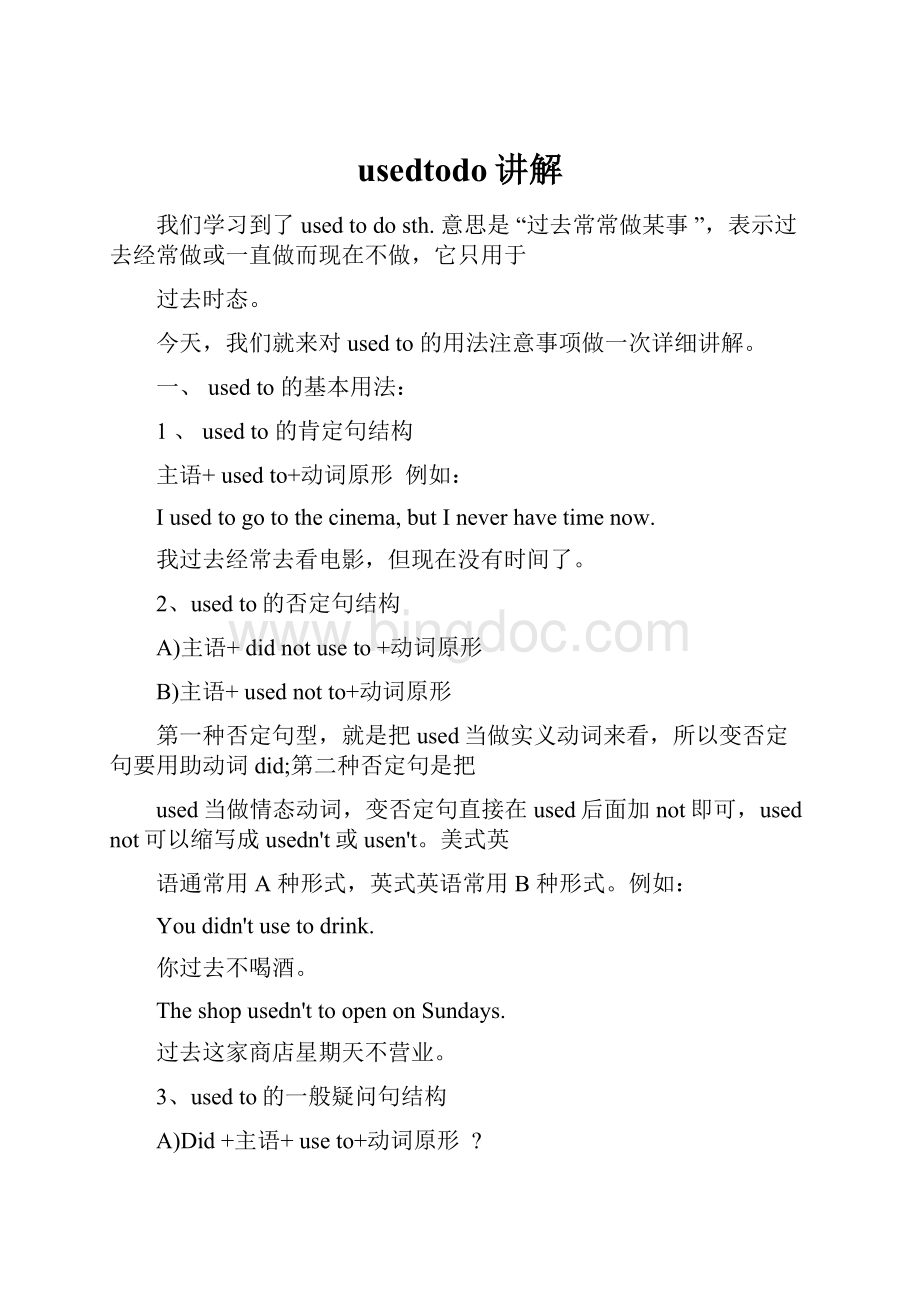usedtodo讲解.docx
《usedtodo讲解.docx》由会员分享,可在线阅读,更多相关《usedtodo讲解.docx(19页珍藏版)》请在冰点文库上搜索。

usedtodo讲解
我们学习到了usedtodosth.意思是“过去常常做某事”,表示过去经常做或一直做而现在不做,它只用于
过去时态。
今天,我们就来对usedto的用法注意事项做一次详细讲解。
一、usedto的基本用法:
1、usedto的肯定句结构
主语+usedto+动词原形例如:
Iusedtogotothecinema,butIneverhavetimenow.
我过去经常去看电影,但现在没有时间了。
2、usedto的否定句结构
A)主语+didnotuseto+动词原形
B)主语+usednotto+动词原形
第一种否定句型,就是把used当做实义动词来看,所以变否定句要用助动词did;第二种否定句是把
used当做情态动词,变否定句直接在used后面加not即可,usednot可以缩写成usedn't或usen't。
美式英
语通常用A种形式,英式英语常用B种形式。
例如:
Youdidn'tusetodrink.
你过去不喝酒。
Theshopusedn'ttoopenonSundays.
过去这家商店星期天不营业。
3、usedto的一般疑问句结构
A)Did+主语+useto+动词原形?
B)Used+主语+to+动词原形?
美式英语通常用A种形式,英式英语用B种形式。
例如:
Didyouusetogoswimmingintheriverwhenyouwereyoung?
你小时候经常在河里游泳吗?
Usedhegotoschoolbybike?
他过去骑车上学吗?
4、usedto用于省略句时,肯定式保留to,否定式不保留to。
例如:
——Usedyouplaybasketball?
你过去常打篮球吗?
——Yes,Iusedto.(No,Iusedn't.)是的,经常打。
(不,不常打。
)
二、区分beusedto与usedto
1、beusedto意为“习惯于”,其中的to是介词,所以其后要接名词或动名词(不能接动词原形);若
要强调从不习惯到习TM的过程,可用get,become等代替动词get,becomebe。
如:
Heisusedtolookingafterhimself.
他已习惯于自己照顾自己。
I’msureI’llgetusedtothehardwork.
我相信我会习惯这艰苦工作的。
2、usedto意为“过去经常”,其中的to是不定式符号,而不是介词,所以其后只接动词原形(不能
接动名词)。
如:
HeusedtoliveinParis.
他过去一直住在巴黎。
Ialwaysused[usedalways]tobeafraidofdogs.
我过去总是怕狗。
三、usedto与would的不同用法
1、usedto可表示过去的习惯动作或状态;而would只表示过去的习惯动作,不接表示认识或状态的
动词。
例如:
Kateusedtobeamodelworker.
凯特曾是一位模范工人。
(例句中的usedto不能用would代替。
因为所用的动词都是静态动词,只是说明一种事实或状态。
)
2、usedto表过去与现在或过去某时与后来的情况不同,强调“现在已无此习惯了”;而would只表示
过去的情况,与现在无关。
只表示说话人对过去的一种回想心情。
例如:
Whenhewasyoung,hewouldsmokealot.
他年轻时,总是吸很多烟。
(现在可能吸,也可能不吸了。
)
(句中的usedto不能用would代替,因为would不含有现在不再这样了”之意。
)
3、usedto泛指过去的习惯性动作或状态,可无时间状语,不能与表示一段时间的状语连用;而would
表示过去的习惯性动作时,往往要带有时间状语,常与often,frequently,sometimes,forhours等连用。
例如:
Hewouldsitforhours,deeplythinking.
他过去经常一坐好几个小时沉思着。
People___thinkthatthesunwentroundtheearth.
A.wouldB.areusedtoC.usedtoD.areused
⑴usedtodosth.过去常常(现在已不如此)
Weusedtogrowbeautifulroses.
注意:
否定句和疑问句有两种
Youusedn’ttomakethatmistake.
Shedidn'tuse(d)todoit,didshe?
Youusedtosmokeapipe,didn'tyou?
/use(d)n'tyou?
【区别】
(2)be/get/becomeusedto+n./doing习惯于
Ihavealwaysbeenusedtohardwork.
Hegotusedtolivinginthecountry.
⑶beusedtodo被用来做
Thisknifeisusedtocutbread.
表示过去常常”时,usedto与would区别:
⑴would只强调过去常常",usedto说明现在不是如此。
Theoldwomanwouldsitthereforhoursdoingnothing.
(3)would只接行为动词,usedto可接行为动词和表状态的词。
如:
be,like,know,have。
Thereusedtobea
templeatthefootofthemountain单项选择:
()1.IalotbutIdon
A.usetoplaytennis
C.amusedtoplaytennis
'tplayveryoften、now.(09
B.wasusedtoplaytennis
D.usedtoplaytennis
()2.Heusedtotoworkbybus,butnowhegoestoworkfoot.(09徐州)
A.going;onB.going;byC.go;onD.go;by
()3.Theyoungmanusedtotowork,butheisusedtotoworknow.(09宿迁)
A.drive;walkingB.drove;walkedC.drive;walksD.driving;walk
()4.Sheusedtowithherparents,butnowsheisusedtowithherclassmates
atschool.(08泰州)
A.live;livingB.live;liveC.living;livingD.living;live
()5.Heusedto__inasmallvillage,butnowhehasbeenusedto__inthebigcity.(08镇江)A.live;livingB.live;liveC.living;livingD.living;live
()6.UnlikeChinese,Americanstheirmealswithknivesandforks.(2010无锡)
A.usedtotakingB.areusedtotaking
C.usedtotakeD.areusedtotake
()7.MrsGreengotohospital,butnowsheisingoodhealth.(08南通)
A.hastoB.needstoC.usedtoD.oughtto
动词填空:
1.Mycousinisusedto(study)withhisnewfriendsinAustralia.(08南京)
2.Myparentsusedto(get)upat7,butnowtheygetupat6andcookbreakfast
forme.(2010淮安)
usedto的用法
usedto是一个固定结构,它的意思是“过去经常、以前常常”,它的后面用动词原形,它表示过去存在某种状态或者过去的某种经常性、习惯性的行为或者动作,并意味着这种动作目前已经不存在,所以它只能用一般过去时,不能用现在时态。
1.它的陈述句的肯定形式:
主语+usedto+动词原形。
例如:
Iusedtoplaywithmyfriendsafterschool.过去放学后我常常和朋友们一起玩。
2.它的否定形式:
主语+didn't+useto+动词原形。
例如:
Youdidn'tusetolikepopsongs.你过去常常不喜欢流行歌曲。
3.它的一般疑问句形式:
Did+主语+useto+动词原形+其他?
例如:
Didyoursisterusetobequiet?
你的妹妹过去常常是很安静吗?
4.usedto的状语可以用副词always,often,sometimes等,但是仍然是过去的习惯,不是指现在的习惯,所以不能用一般现在时。
例如:
Healwaysusedtobelateforclass.他过去常常上课迟到。
5.usedto可以用在therebe结构中表示“过去经常有”的意思。
例如:
Thereusedtobealotoffishesinthisriver.过去这条小河常常有许多鱼。
6.beusedtodosomething的意思是“被用来做某事”,是动词短语use...todo的被动语态结构,used是动词的过去分词。
它可以用各种时态。
例如:
Knivesareusedtocutthings.小刀是用来切东西的。
7.beusedtodoingsomething的意思是“习惯于做某事”,to的后面用动名词,它可以用现在、过去和将来等时态,be可以用get,become连系动词代替。
例如:
Myfatherisusedtolivinginthevillage.我爸爸习惯于住在小山村。
语法专练
I.Mary,youbeshort,butnowyouaretall.
A.wereB.areC.usetoD.usedto
【答案与解析】答案是d。
本句子是考查动词短语usedto的用法。
从本句子的意思理解是用usedto
表示“过去常常很矮”的意思。
8Mymotherusstorieswhenwewerechildren.
A.wasusedtotellB.isusedtotellingC.usedtotellD.usedtotelling
【答案与解析】答案是Co从本句子的意思“我妈妈过去常常给我们讲故事”可以理解是用usedto+动词原形表示过去常常。
9usedtoanoldbookshelfinmyroom.
A.There;beB.There;haveC.It;beD.There;having
【答案与解析】答案是Ao本句子是考查therebe和usedto连用的用法,表示“过去常常有”的意思。
10Thereusedtobeariverhere,?
A.usedthereB.didn'tthereC.wasn'titD.didit
【答案与解析】答案是B。
本句子是考查反意疑问句的用法,前面是肯定形式,后面用否定形式,排
除A和D,后面的疑问句主语和前面保持一致,所以
C不对。
11Mybrotherhasbeenusedinthevillageschool.
A.toworkingB.toworkC.workingD.work
【答案与解析】答案是a。
本句子的beusedtoworking是表示“习惯于工作”的意思,这个短语的后面用动名词形式。
一、由"what"引导的感叹句:
"what"意为"多么"用作定语,修饰名词(被强调部分),单数可数名词前要加不定冠词a/an,复数可数名词或不可数名词前不用冠词。
这类句子的结构形式是:
what+(a/an)+adj.+n.+主语+谓语+(itis).
如:
1Whataclevergirlsheis!
多么聪明的姑娘呀!
2Whataninterestingstoryitis!
多么有趣的故事呀!
3Whatgoodchildrentheyare!
他们是多么好的孩子呀!
4Whatbeautifulflowerstheyare!
多么漂亮的花呀!
5Whatdeliciousfooditis!
多么有味的食物呀!
6Whatheavysnowitis!
多么大的雪呀!
二、由"how"引导的感叹句:
"how"意为"多么",用作状语,修饰形容词或副词(被强调部分)。
如果修饰形容词,则句中的谓语动词用系动词;如果how修饰副词,则句中的谓语动词用行为动词,这类句子的结
构形式是:
How+adj.(adv.)+主语+谓语+(itis).
如:
①Howcolditistoday!
今天多么冷呀!
7Hownicethepicturesare!
多么漂亮的图画呀!
8Howhappytheylook!
他们显得多么高兴呀!
9Howwellshesings!
她唱得多好呀!
10Howhardtheyareworkingnow!
他们干得多么起劲呀!
提问人的追问2011-05-0116:
03
how+形容词或副词。
。
。
但是为什么有的题目how后面有an
forexample:
excitingnews
how或what开头。
感叹句是表示喜、怒、哀、乐等感情的句子。
感叹句一般用
一、what引导的感叹句结构有三种:
1.What+(a/an)+形容词+可数名词单数+其它!
2.What+形容词+可数名词复数+其他!
3.What+形容词+不可数名词+其他!
例如:
(1)Whatagreatpityyoumissedthelectureagain!
你又一次错过了讲座,真是太遗憾了!
(2)Whatinterestingbooksyouboughtus!
你给我们买的书真有趣!
(3)Whatfineweatheritis!
多么晴朗的天气呀!
二、how引导的感叹句结构有:
1.How+形容词+主语+谓语!
2.How+副词+主语+谓语!
例如:
(1)Howbeautifultheflowersare!
这些花是多么美丽呀!
(2)Howheavilyitisraining!
雨下得是多么大呀!
how和what都用来引导感叹句,它们有什么区别呢?
how在这里是一个副词,用来修饰形容词和
副词;而what是用来修饰名词的,所以即使是同样的句子,how和what引导的句子结构是不一样的。
请看下列例句:
(1)多美丽的一朵玫瑰花呀!
Howbeautifularoseitis!
Whatabeautifulroseitis!
(2)多晴朗的天气呀!
Howsunnytheweatheris!
Whatsunnyweatheritis!
(3)这些学生是多么聪明呀!
Howcleverthestudentsare!
Whatcleverstudentstheyare!
【巩固练习】按要求改写下列句子。
1.Lucyisaveryclevergirl.(用what改写为感叹句)
2.Lilyisaverybeautifulgirl.(用how改写为感叹句)
3.Thestudentsareplayingbasketballhappily.(用how改写为感叹句)
4.Thebooksareverynew.(用what改写为感叹句)
5.Thestoryisveryinteresting.(用what改写成感叹句)
6.Thebookisveryinteresting.(用how改写成感叹句)
7.Kangkang'slectureiswonderful.(用how改写成感叹句)
8.Thenewsisveryimportant.(用what改写成感叹句)
参考答案:
1.WhataclevergirlLucyis!
2.HowbeautifulagirlLilyis!
3.Howhappilythestudentsareplayingbasketball!
4.Whatnewbookstheyare!
5.Whataninterestingstoryitis!
6.Howinterestingabookitis!
(Howinterestingthebookis!
)
7.HowwonderfulKangkang'slectureis!
8.Whatimportantnewsitis!
2、how引导的感叹句,基本结构是:
How+形容词/副词+主语+谓语!
(主谓可省略)
eg.Howbeautifultheparkis!
3、What引导的感叹句:
基本结构是:
①What+a/an+形容词+可数名词(单数)+主语+谓语!
(主谓可省)
eg.Whatanicegirl(sheis)!
②What+形容词+可数名词复数(或不可数名词)+主语+谓语!
eg.Whatbeautifulflowerstheyare!
注意:
What感叹不可数名词时,名词前面不能加不定冠词a/an。
eg.Whatagoodnewsitis!
类似的有:
Whatbadweather!
Whathardwork!
Whatdeliciousfood!
等
典型例题
1)___foodyou'vecooked!
A.HowaniceB.WhataniceC.HowniceD.Whatnice
答案D.由于How修饰形容词,副词;what修饰名词。
且food为不可数名词,因此A,B排除。
CHow+adj.后
面不能再加名词,因此只有D正确,其句型为What+adj.+n.(不可数)
2)___terribleweatherwe'vebeenhavingthesedays!
A.WhatB.WhataC.HowD.Howa
答案A.weather为不可数名词,B,D排除。
C为how+adj.后面不应有名词。
只有A,符合句型What+形容词+不可数名词。
1.TheTVplayisinteresting.
interestingtheTVplayis!
2.We'vereadthenicebook.nicebookwe'veread!
3.Youboughtcheappotatoes.cheappotatoesyoubought!
4.It'saveryexpensivecoat.expensivethecoatis!
5.TheTVplayisveryinteresting.
interestingTVplayitis!
6.We'vereadthenicebook.
nicebookwe'veread!
7.It'saveryexpensivecoat.expensivethecoatis!
8.Youboughtcheaptomatoes.
cheaptomatoes.
9.Heworkshard.hardheworks!
10.Theweatherwasbadyesterday.
badweatheritwasyesterday!
11.It'sabeautifulcity.beautifulcityitis!
12.She'saclevergirl.cleverthegirlis!
13.It'saninterestingfilm.interestingthefilmis!
14.Theboyisrunningveryfast.fasttheboyisruning!
答案:
1.How2.Whata
3.What4.How
5.Whatan.TVplay是单数可数名词,故应在interesting前加不定冠词an.
6.Whata.book是单数可数名词。
7.How
8.What
9.How
10..What
11..Whata
12..How
13.How14.How
1/bigthetreeis!
A/whatb/howc/whata
2/weatherwehadonourholiday!
a/whatagoodb/howagoodc/whatgoodd/howgood
3/goodboyheis?
a/whatb/howc/whatad/howa
4/largethefactoryis!
a/howb/whatc/what